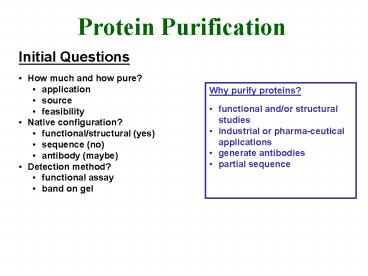Protein Purification - PowerPoint PPT Presentation
1 / 14
Title:
Protein Purification
Description:
partial sequence. Developing a Protein Purification Scheme ... Wash membrane extensively with H2O before sequence analysis. ... fiber filters and sequenced ... – PowerPoint PPT presentation
Number of Views:495
Avg rating:3.0/5.0
Title: Protein Purification
1
Protein Purification
- Initial Questions
- How much and how pure?
- application
- source
- feasibility
- Native configuration?
- functional/structural (yes)
- sequence (no)
- antibody (maybe)
- Detection method?
- functional assay
- band on gel
- Why purify proteins?
- functional and/or structural studies
- industrial or pharma-ceutical applications
- generate antibodies
- partial sequence
2
Developing a Protein Purification Scheme
- carry out small pilot experiments to evaluate
various separation techniques - start with rapid high capacity techniques (which
are generally low resolution) and progress to
high resolution low capacity techniques
3
Capacity vs. Resolution
4
Developing a Protein Purification Scheme
- carry out small pilot experiments to evaluate
various separation techniques - start with rapid high capacity techniques and
progress to high resolution low capacity
techniques - minimize time and number of manipulations
whenever possible - eg, arrange methods to minimize buffer changes if
other factors are equal - exploit unique features
5
Exploiting Unique Features
- affinity chromatography
- CaM ? Ca2/hydrophobic
- subunits vs. complex (gel filtration)
6
Evaluation of Protein Purification
- qualitative (gel electrophoresis)
- quantitative
- recovery ( yield)
- fold-purification
7
(No Transcript)
8
Protein Sequencing
- partial sequence data
- identify protein by homology
- design DNA probes
- assess purity
- automated Edman degradation
- protein bound to solid support
- N-terminal residues sequentially removed
- identified by HPLC
- possible after gel electrophoresis
9
N-terminal Sequencing Needs
- relatively pure sample (gt80)
- 10-100 pmoles of protein
- 0.5-5 mg for 50 kDa
- unblocked N-terminus
- free of contaminants (Tris, glycine, SDS,
acrylamide, etc.)
10
Microsequencing Procedure
- Purify protein so that it is a major band
resolved from contaminants. - Gel electrophoresis (1- or 2-D)
- Transfer protein to membrane support following
electrophoresis. - Stain membrane and excise protein band of
interest. - Wash membrane extensively with H2O before
sequence analysis. - Submit membrane to sequencing service.
11
Protein Transfer
- electrophoretic transfer using special apparatus
- PVDF membranes
- good protein retention
- chemical resistance
- transfer in buffer with 10 MeOH to reduce SDS
- optimize transfer time
- smaller proteins transfer faster
- larger proteins retained better
- 0.22 and 0.45 mm pore size
- produces replica of gel
12
Microsequencing Procedure
- Purify protein so that it is a major band
resolved from contaminants. - Gel electrophoresis (1- or 2-D)
- Transfer protein to membrane support following
electrophoresis. - Stain membrane and excise protein band of
interest. - Wash membrane extensively with H2O before
sequence analysis. - Submit membrane to sequencing service.
13
Internal Sequencing
- treat protein with site-specific protease or
chemicals
14
Internal Sequencing
- peptides generally isolated by reverse phase
(HPLC) chromatography
- peaks dried onto glass fiber filters and sequenced































